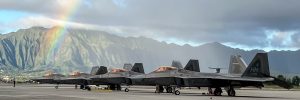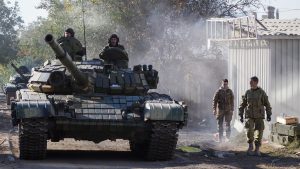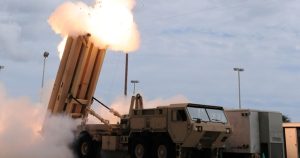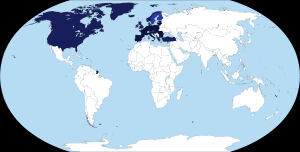Threat Analyst Ken Abramowitz
is author of “The Multifront War”
Editor: Dr. Rachel Ehrenfeld,
President, American Center for Democracy (ACD)
QUOTE OF THE WEEK:
“You and I have the courage to say to our enemies, ‘There is a price we will not pay.’ ‘There is a point beyond which they must not advance.’ And this — this is the meaning in the phrase … Peace through Strength”.
Ronald Reagan, 40th President of the United States
40th President of the United States
Every year, Congress passes a National Defense Authorization Act, which allocates the resources to develop, procure, operate, and sustain the U.S. armed forces. To avert war, Congress should dramatically raise the President’s proposed budget of $886.3 billion for fiscal year 2024 to close the gaps with its main adversaries: China, Russia, and Iran. A strong US military is much more likely to deter America’s enemies, and if deterrence fails, defeat them on the battlefield.
 The U.S. must be prepared to fight kinetic and cyber wars with these enemies and their proxies. During and after WW2, the US had a two-simultaneous-war strategy. It must move to a fully funded three-war plan as quickly as possible.
The U.S. must be prepared to fight kinetic and cyber wars with these enemies and their proxies. During and after WW2, the US had a two-simultaneous-war strategy. It must move to a fully funded three-war plan as quickly as possible. An extra challenge is that each of these enemies presents different geographical theaters and functional threats. The Russian front in Europe requires traditional land war weapons. The China front requires aircraft carriers, destroyers, aircraft, refueling capabilities, and long-range anti-ship missiles, while the Iranian front requires exquisite bunker-busting technologies. All require an immediate upgrading of US cyber defensive and offensive capabilities.
An extra challenge is that each of these enemies presents different geographical theaters and functional threats. The Russian front in Europe requires traditional land war weapons. The China front requires aircraft carriers, destroyers, aircraft, refueling capabilities, and long-range anti-ship missiles, while the Iranian front requires exquisite bunker-busting technologies. All require an immediate upgrading of US cyber defensive and offensive capabilities.
 Having sent over $40 billion of weapons to aid Ukraine in the past two years, the US must continue to replenish this inventory at home and abroad in Europe, the Middle East, Israel, and South Korea as fast as possible. To improve supply chain resilience, the US must offer long-term multi-year munitions contracts of at least three to six years to its weapons manufacturers so they can plan accordingly.
Having sent over $40 billion of weapons to aid Ukraine in the past two years, the US must continue to replenish this inventory at home and abroad in Europe, the Middle East, Israel, and South Korea as fast as possible. To improve supply chain resilience, the US must offer long-term multi-year munitions contracts of at least three to six years to its weapons manufacturers so they can plan accordingly.
 The US must spend an extra $2-$4 billion annually on Navy and Air Force launched long-range anti-ship missiles, and procure more systems to deliver these weapons. On the Russian front, it has to increase its spending on ground-to-ground artillery and missiles, particularly long range ATACMS (Army Tactical Missile Systems).
The US must spend an extra $2-$4 billion annually on Navy and Air Force launched long-range anti-ship missiles, and procure more systems to deliver these weapons. On the Russian front, it has to increase its spending on ground-to-ground artillery and missiles, particularly long range ATACMS (Army Tactical Missile Systems).
 In addition, it must increase its spending to build up its anti-missile defenses against a potential North Korean and Iranian nuclear attack, and the attack systems to remove these existential threats.It must also fulfill the $14 billion backlog of promised weapons to Taiwan (these will be purchased by Taiwan, but the US must make them available). Simultaneously, the US must learn to adopt innovative and cheaper solutions faster whenever possible to fill gaps in its capabilities.
In addition, it must increase its spending to build up its anti-missile defenses against a potential North Korean and Iranian nuclear attack, and the attack systems to remove these existential threats.It must also fulfill the $14 billion backlog of promised weapons to Taiwan (these will be purchased by Taiwan, but the US must make them available). Simultaneously, the US must learn to adopt innovative and cheaper solutions faster whenever possible to fill gaps in its capabilities.
 To achieve all this, the US must immediately increase its defense budget by $20-40 billion annually in weapons procurement to defeat the Russian army, while intimidating China and Iran from testing its abilities and resolve.
To achieve all this, the US must immediately increase its defense budget by $20-40 billion annually in weapons procurement to defeat the Russian army, while intimidating China and Iran from testing its abilities and resolve.
 The US must also convince ALL of its NATO allies to spend at least two percent of their GDP on national defense, although three percent is more appropriate.
The US must also convince ALL of its NATO allies to spend at least two percent of their GDP on national defense, although three percent is more appropriate.
 Raising spending on national defense is expensive, but the investment is well worth it. A strong military could prevent a much more costly war!
Raising spending on national defense is expensive, but the investment is well worth it. A strong military could prevent a much more costly war!






